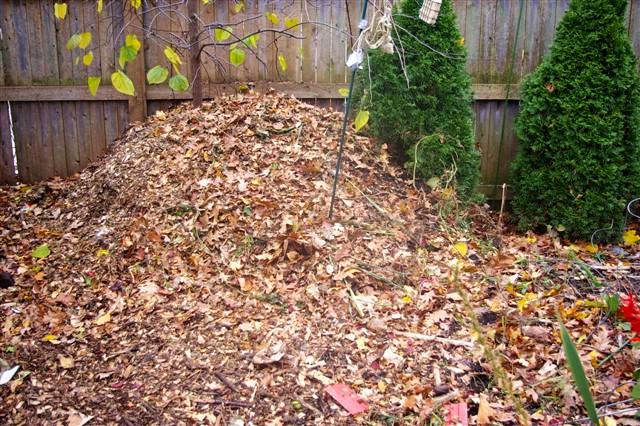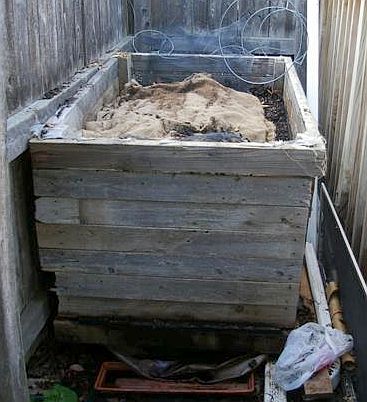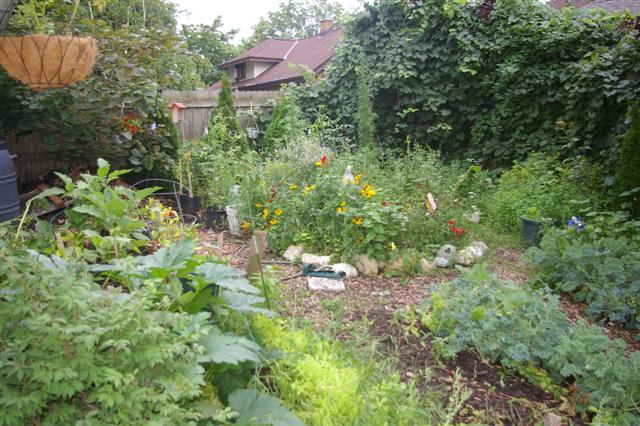
Worm Depository 11/06/07My friend Godsil, co-founder of the Milwaukee Renaissance, wrote a draft for a Holiday Gift, a “City Farm Startup Kit” for Spring 2008. Godsil is a board member of Growing Power and is the person who inspired me to get into the home model of Growing Power. However his draft kit did not mention worms or worm-related components like worm condos or a worm depository (see picture). Worms are at the heart of Growing Power. When I mentioned that to him he suggested that I draft my own Startup Kit, based on my experiences the last two years in applying the Growing Power model to home and garden. It is much too early for me to talk about Holiday gifts, but since some components of this kit need immediate attention here goes: the first part of the kit. More will follow and by the Friday after Thanksgiving, the official start of the Holiday buying spree, I should have it finished. The entire kit should be posted on the Growing Renewable Affordable Food GRAF site as it unfolds.
Parts of this startup kit will have two versions; one will be for those who want to give our GP home model garden to themselves or another at the most — extremely — affordable price, and the other version, in parentheses “( )”, will be for those who want to purchase some of the ingredients or components.
All the steps apply whether your garden is a few pots on your deck, in a window box, or in an outside garden, small or large. Only the dimensions vary. The rest is the same old, same old. Also I will try to use terms that everyone is familiar with or that can be found in the Glossary.
Step 1: Making soil
(Part of this step can be skipped if one wishes to purchase already made compost from Growing Power at $75 a square yard, about three wheel-barrows full.)
You need to gather, as soon as possible or add to an existing pile, the ingredients for compost. You will need some space outside that gets plenty of air, rain and snow, but is somewhat blocked-off, like with chicken wire, fencing or something. The ingredients of compost are 75% Carbon and 25% nitrogen. Carbon is wood chips (free from the city dump), leaves (free everywhere), shredded paper, torn up cardboard and such. Nitrogen is kitchen scraps (no meat or dairy products) overripe vegetables and fruits from grocery stores or markets, coffee grounds from coffee shops, brewer’s waste from a brewery, garden waste from this year like grass or plants and such. Gathering the ingredients will cost you time and transportation but they are all easily available at no cost.
Since you are going to leave the compost to cook over the winter you can put it in layers on your compost pile, making sure the bottom and top layer are always carbon. This will keep critters away from your compost. To speed things up a little you may want to use a pitchfork to mix up the pile occasionally, until the pile is frozen.
If you already have a compost pile started you might just want to add to it and to add some worms, free from Growing Power to good worm owners. The worms will work during the winter, eating the compost and making the bottom of the pile a castings-enriched compost. If you are using worms make sure there is a thick coat of wood chips and/or leaves on top. This will freeze and the worms will be warm and cozy inside (see above picture).
(If you purchase already-cooked compost from Growing Power you may want to ask them for some free worms.) When spring comes you will want to turn this compost pile over, the bottom being enriched compost for the garden and the top being the bottom of a new pile of compost.
As my Italian wife says of basil: “You can never have too much”. This applies to compost. When the ingredients of the compost pile break down (“cook”), the remaining pile will be only ¼ of its original size.
So step one is to purchase or gather compost now. Total cost so far is $0 or $75. For more information on this Gift of a GP Home Garden you can check the Diary of a Worm or GRAF web pages.
Step 2: Seeds and Castings

Worm CondoThis is part two of the article about creating a Growing Power gift that I started last week. Now that you have the ingredients for Growing Soil, it is time to purchase, gather, or make the rest of “The Gift that Keeps on Giving.” The next part of the gift is something that you will need to purchase for the garden, and that can be a gift to wrap for under your tree, which is the seeds. You can purchase seeds from Growing Power, a garden store, or from one of the many seed catalogs. The catalog I used, originally recommended to be by Will Allen at Growing Power, is “Johnny’s Selected Seeds”. They can be reached on the web at www.johnnyseeds.com or by phone at 800/738–6314. What seeds you order depends on a number of factors: 1) Your tastes and interests or those of the person you are giving the gift to; 2) Your growing space or that of the person you are giving the gift to. It could range from one large pot on the deck, to a small garden, to a large garden. My suggestions for the GP garden beginner is to stick with the easy and fast-growing items: lettuce mixes, green mixes, certain herbs like basil and mints and some vegetables like tomatoes, eggplants, squashes, cucumbers, peppers etc. depending on taste, conditions, room and soil. My experience with making your own soil is that even using the same soil and same seeds, two plants will grow differently, because of conditions, in two gardens. This year I gave Dawn of the DMZ Garden Co-op some of the same soil for mounds and the same zucchini seedlings I used, yet hers were many times more fruitful than mine. Discovering what seeds to buy, when to plant them, and where, is a learning experience and part of the gift.
The second part of part two is a Worm Condo. I am a firm believer that every garden, big or small, should have a worm condo. This is the outside box, big or small, where the livestock, the worms, eat the compost you make and turn it into the ‘black gold’ of castings. These castings are the black rich soil, full of living organisms, that so enriches the seeds that you can plant a lot in a small space. You can see a picture of a worm condo and some instructions at Worm Condo. Build a large or small one from scrap wood. Make sure you leave cracks between the boards on the bottom of the box so the water that seeps through the compost and castings can drain. The box built in my yard is square but the back legs are higher than the front. By using plastic stapled on the box it drains toward the front where it can be collected in a container. The water, now “tea”, can be put back into the box or used to waster plants. Depending on the material used, scrap or new, and depending on one’s skills to construct it, this part of the gift could cost from $0 to $50.
So in this Part II of the Gift that Keeps on Giving we have the seeds and castings-enriched or tea-enriched, fertile soil that we need for a Growing Power home model garden.
Step 3: Resources

Growing Power Home GardenThis is part three of the Growing Power Gift - The Gift that Keeps on Giving article that was started a few weeks ago. In Part One you discovered the ingredients for Growing Soil. In Part Two you discovered the seeds and worm-enriched soil and organic fertilizer you need for a Growing Power home model garden. In Part 3 you will find components and advice to complete the gift that keeps on giving.
Seeds can germinated in the house, sunroom, outside in a greenhouse or right in the soil. Whatever way the seedlings are germinated, they need to be planted in mounds in the GP garden, in the GP box, or in a planter inside or outside in the same old, same old soil. The ingredients in each case are the same, thus the name given to it by Will Allen of Growing Power, “same old, same old.” The basic soil in which you plant the seeds, “same old, same old”, is a base of rough compost topped with worms with a mix of castings and coir (coconut shavings) on top.
With this worm-enriched soil, light, water and castings tea, you are ready to grow. Now all you need is the toil and time to make the garden, inside or out, grow. Below are resources that you can give as part of the Gift. Some are free, some cost money, and some cost work.
A major resource is the world headquarters of Growing Power at 55th and Silver Spring in Milwaukee. Growing Power runs weekend workshops on this method of growing. They are hands-on and an excellent way to learn. (Also the organic food they serve for meals is delicious.)
Of course there are my pages Diary Of a Worm, GRAF Growing Renewable Affordable Food, the Glossary (soon to be expanded) and more. On these pages you can find information about worm depository, rain barrels and much more.
Soon there will be DMZ garden mini-site, about the efforts of Dawn, Marna and myself to grow affordable, renewal food (GRAF) in the central city. To join us in this cooperative effort just contact us at DMZ@nonviolentworm.com.
On the Milwaukee Renaissance Growing Power Home Page and the Green Weekly Updates you will find a wealth of information.
A good resource is James Godsil, (
), co-founder of Milwaukee Renaissance and board member of Growing Power, Inc. He has his own urban farm in his backyard in Bay View. Godsil is a ‘peddler’ and can lead you to many other persons and resources who can be of service to you.
Here are three persons that were significant to my GP home model garden, inside and out:
- Andor (
), a creative carpenter who built The Plant Stand and The Vertical Grower that you can find in the System Components.
- John (
), who built the five-pane windows to turn my unheated sunroom into a Green House. Once this energy saving method is tested there will be more on the GRAF pages about it.
- Loren, (
), who built the Growing Power box in my sunroom and the worm condo outside.
Also, I would be remiss if I did not mention the person who made this and many other growing power wiki web pages possible, Tegan Dowling of Emergency Digital.